Our elders told us of many health benefits of bee bread, but science confirmed only some of them. Hepatitis, heart and blood circulation diseases, anemia, high blood pressure, are probably the most important.
Bee bread is fermented bee pollen. Not artificially made (here is how you can do bee bread at home), by humans, but by bees, which add some of their saliva and some honey over bee pollen.
Starting from here, we can only guess that the qualities of simple bee pollen are much improved, thus enhancing the effects they bring to our health. (Read here about the differences between bee pollen and beebread.)
Bee bread is known under other names, such as perga or ambrosia. And it can be written in different ways: beebread, bee bread or bee-bread. There is no consensus on how to write it. Oxford Dictionary doesn’t have it in either form.
The active ingredients are easily digested by the human body and have a natural curative effect on the physiological state of the organs and tissues. A 2022 study emphasized that :
Bee bread is characterized by considerable pharmacological properties, proven in vitro and in vivo. Thus, it can be stated that bee bread offers a wide field for the exploitation of its benefits in the food and pharmaceutical industries.
Health benefits of bee bread
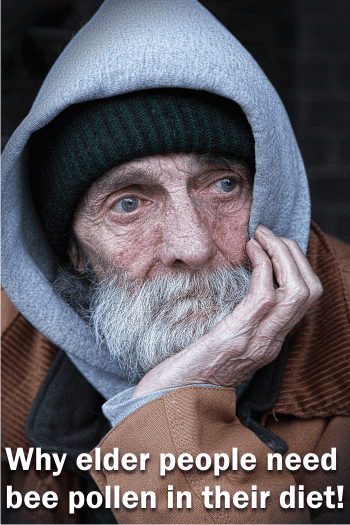
It is also very efficient in treating urinary disorders and prostate issues. It improves appetite, improves skin tone and has a rejuvenating effect on the body.
Though there are very few studies of this bee product, lately research focused on finding more about it.
Antioxidant activity
Bee bread was found to have high antioxidant activity (Nagai et al., 2004; Baltrusaityte et al., 2007b).
Research has indicated that for antioxidant and antimicrobial properties of honey, it is beneficial to enrich it in both bee bread and propolis.
The new 2017 study “Functional properties of honey supplemented with bee bread and propolis.”, by Kowalski S et al, Poland, found that bee bread had the most significant influence on antioxidant properties. They tested honey enriched with propolis and bee bread for their antioxidant and antimicrobial effects.
Hepatitis
Ialomicianu et al. showed in 1976, on 110 deteriorating chronic hepatitis patients, that an intake of 30 g bee bread for 30 days or fresh pollen daily for 90 days normalized albumin/globulin blood ratio.
The patients taking bee bread had the ratio changed from 0.96 to 1.27 while in patients taking pollen from 0.85 to 1.26.
Bee bread is 3 times more powerful than fresh bee pollen!
Heart and blood circulation diseases
In 2010 Kassaynko treated adult patients with dislipidia with bee bread. For 12 weeks he gave them 40g bee pollen and bee bread daily. The resulted in cholesterol decrease by 11.4, resp. 20.5 %.
The same quantity of bee bread decreased triglicerides by 12.5 % and HDC by 14.3 %.
Anaemia
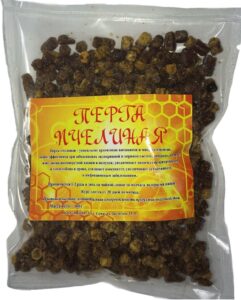
Bee bread (as only medicine) was administered to 20 patients suffering from anaemia.
The patients received of pure bee bread or a 1:1 mixture of bee bread and honey, three times a day for more than a month, as follows:
– a teaspoon to adults;
– 1/3 teaspoon to children up to a year;
– ½ teaspoon for children from one year onward.
The health condition of the patients improved during the therapy. The patients appetite increased, they were more lively, better humored and gained weight. Furthermore, their headaches, debility, vertigo and tiredness receded.
Epidermis and mucous membranes were less pale and the hemoglobin and their number of erythrocytes increased. The study’s conclusion was that bee bread is suitable for the treatment of anemia.
The same conclusion is supported by a Bulgarian report as well (GEORGIJEWA, E et al., 1993)
“From biological point of view, the most effective pollen forms are bee bread and fresh frozen pollen.” (Stefan Bogdanov, 2014)
Arterial hypertension (high blood pressure)
In 2009 Liferov et al.treated 57 patients, men and women, with 15 g bee bread taken twice a day, for 45 days.
The results showed that total cholesterol decreased by 24 %, LDL by 36 %, HDL increased by a factor of 2.1.
Antimicrobial activity
The study “Antibacterial Activity of Honey and Beebread of Different Origin Against S. aureus and S. epidermidis”, by Vilma Baltrusaityte et al from Lituania, aimed to evaluate the antimicrobial properties of honey and bee bread products of different origins. 34 honey and 4 beebread samples were tested against Staphylococcus aureus and Staphylococcus epidermidis.
It was found that the antibacterial activity was dependent on hydrogen peroxide formation, and depended a lot on the floral source. Only 3 of the ten tested multifloral honey samples (polifloral spring honey, polifloral summer honey and an unknown sourced honey) inhibited the growth of S. aureus and S. epidermidis.
The concentration should also be higher than 25% (by mass per volume).
S. epidermidis was more resistant to the antimicrobial effects of honey than S. aureus.
As expected, commercially available honey samples did not exhibit antibacterial properties. It is well known that heating honey has a negative influence on its antimicrobial properties. Read more on What is processed honey?
Conclusion: The tested honey samples had antimicrobial activity due to enzymatic formation of hydrogen peroxide. Beebread also showed residual non-peroxide activity, but this was not the only factor that contributed to it.
The study indicates that the use of honey and beebread in food formulations can help control some food pathogen.
Antitumoral effect
Bee bread showed moderate antitumor activity – concluded a 2017 study, “Flavonoid Composition and Antitumor Activity of Bee Bread Collected in Northeast Portugal” by Filipa Sobral et al. Portugal.
This study represents the first report characterizing glycosidic flavonoids in bee bread samples. In the 6 tested samples there have been identified 32 flavonol glycoside derivatives, such as quercetin, kaempferol, myricetin, isorhamnetin and herbacetrin derivatives.
Also very important is that none of the bee bread samples showed toxicity for normal cells, so, yes, the health benefits of bee bread should be taken seriously.
========
References:
• BALTRUSAITYTE, V; VENSKUTONIS, P R; CEKSTERYTE, V (2007) Antibacterial activity of honey and
beebread of different origin against S-aureus and S-epidermidis. Food Technology and Biotechnology
45 (2): 201-208.
•41 DUBTSOVA, E; KOMISARENKO, I; KASSYANENKO, V (2007) Bee pollen and bee bread: biological action and
use in aged people. Clin Gerontol (Russia) 13 (1): 50-52.
• 80 KASSYANENKO, V; KOMISARENKO, I; DUBTSOVA, E (2010) Influence of honey, pollen and bee bread on
serum cholesterin of patients with pathological lipid metabolism (Russian), Beekeeping, apitherapy and life
quality, International Industrial Acadamy, Moscow, 20.May2010: pp 81-82.
•99 LIFTEROVR; FOMIN, W; SHISHKINA, L; AGAFONOVA, W; SOLDATOV, E G E; MARHOVSKAYA I.;
PUSHKAREVA, S (2009) Experience with the use of bee bread for the treatment of dislipidemia of patients
with high or intermediate risk for heart disease having arterial hypertension, Apitherapy today (in Russian),
Ribnoe: pp 54-55.
•116. NAGAI, T; NAGASHIMA, T; MYODA, T; INOUE, R (2004) Preparation and functional properties of extracts from
bee bread
• 188. YAKUSHEVA, E (2010) Pollen and bee bread: physico-chemical properties. Biological and pharmacological effects. Use in medical practice, In Rakita, D; Krivtsov, N; Uzbekova, D G (eds) Theoretical and practical basics of
apitherapy (Russian), Roszdrav; Ryazan;
• GEORGIJEWA, E; WASSILEFF, W (1993) Pollen against Anemia, 29 Apimondia Kongress in Budapest: pp 106.


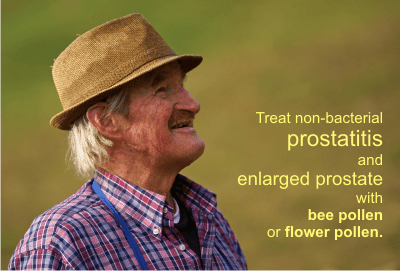
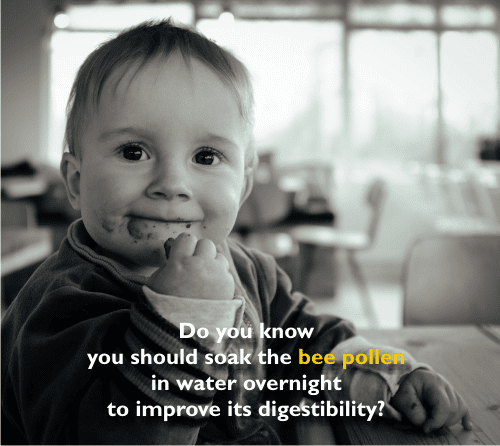
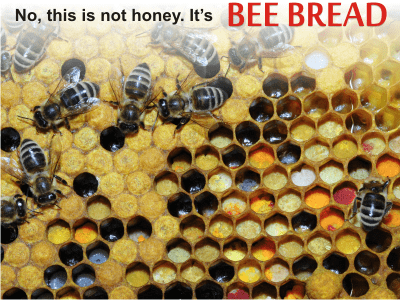
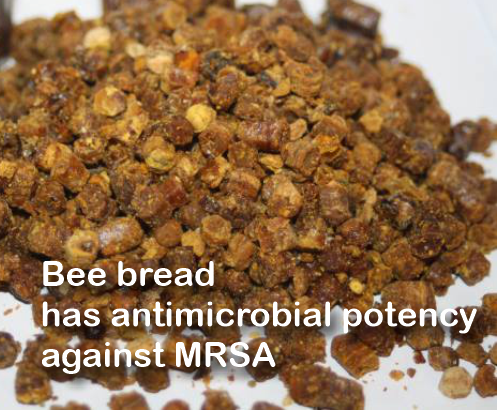

Hi,
first of all so nice to see a Lithuanian researchers reference (Baltrusaityte). We are honeybee keepers from Lithuania and since we started using bee products a quality of life improved significantly. It is interesting to see that you recomend to give a bit of bee bread to children under one year old. Can you give a reference for that recomendation? We would like to share that information too. In our country parents still fear for that, sadly. For us, the best way to use bee bread is to make warm tea of it with honey. Better than coffe!
Hi,
Yes, that recommendation is taken from “Pollen: Production, Nutrition and Health: A Review” by Stefan Bogdanov. You can find it online. My honest advice is not to recommend this commercially, because of the internationally accepted rule of not giving any bee product to children under 1yo. However, many of Bogdanov’s recommendations are extracted from traditional medicine, from direct folk experience. The treatment works, but hasn’t yet been scientifically proved and approved. 🙂
And though the incidence of actually getting botulinum is extremely low, it is better to avoid it.
Do you have any interesting and rare honey in Lithuania that you would like to share it with us?
Cheers,
Laura
Thank You for the reply! We totally agree about the recommendations. In our country most moms are afraid of honey and bee product mostly because of possible allergic reaction rather than botulinum.
Well, since we are from Lithuania, the most valuable honey here is buckwheat. We also collect a lot linden and honeydew (forest) honey.
We also produce honey mixed with dried fruits and berries – amazing taste. Have you tried it? 🙂
Buckwheat honey is indeed a truly medicinal honey. Yes, I’ve tried honey mixed with different dried fruits, vegetables or berries, or infused with different herbs. We also use honey to take essential oils internally, honey enhances their power.
I wish you a good year and an amazing harvest!
Laura